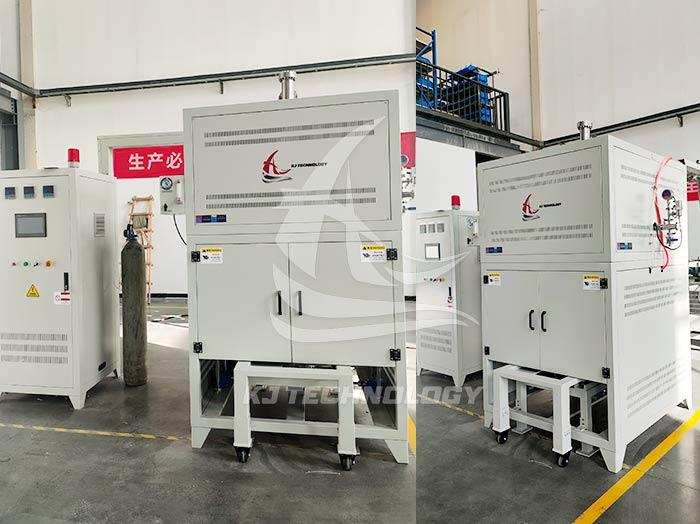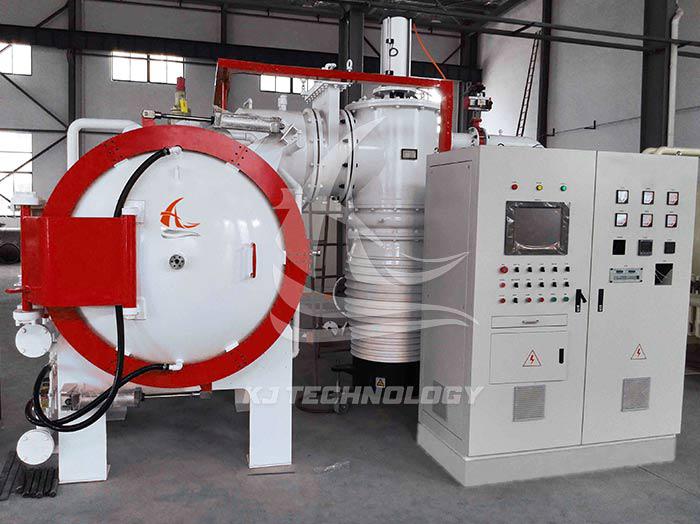Is the heat treatment of vacuum graphite high-temperature furnace good?
 11-06-2025 Author: KJ technology
11-06-2025 Author: KJ technology
The vacuum graphite high-temperature furnace performs excellently in heat treatment and is an ideal choice for many high-precision and high demand heat treatment processes. Its advantages are reflected in the following aspects:
1. Core advantages: high temperature, vacuum and uniformity
High temperature capability
The furnace temperature of the vacuum graphite high-temperature furnace can reach 1600 ℃ to 2800 ℃, far exceeding conventional heat treatment equipment, and can meet the high-temperature treatment needs of ceramics, metals, and composite materials. Graphite heating element has high temperature resistance and excellent conductivity, which can achieve rapid and uniform heating, reduce stress concentration caused by temperature gradient, and avoid workpiece cracking or deformation.
vacuum environment
By vacuuming (with a maximum vacuum degree of 5 × 10 ⁻⁶ mbar) or filling inert gases (such as argon and nitrogen), oxygen can be completely isolated to prevent the workpiece from oxidizing or generating harmful reaction products at high temperatures. This is crucial for easily oxidizable materials such as titanium alloys and stainless steel, or workpieces that require high surface purity such as semiconductors and optical components.
temperature uniformity
Graphite has excellent thermal conductivity and can quickly conduct heat, ensuring uniform temperature distribution inside the furnace. Combined with a multi zone temperature control system (high-end model), the temperature field can be further optimized, suitable for complex shaped workpieces or parts with high dimensional accuracy requirements (such as precision molds and aviation blades).
2. Process effect: Improve material performance
Eliminate processing stress
After the annealing machine is used to process workpieces (such as stamped parts, forgings, welded parts), residual stress is eliminated to prevent deformation or cracking during subsequent use. For example, annealed cold-rolled steel plates can restore their ductility and facilitate subsequent cutting processes.
Improve organizational structure
By adjusting the grain size and phase composition of metals through annealing, the plasticity, toughness, or mechanical properties of materials can be improved. For example, annealing high-temperature alloy blades can improve creep resistance and extend service life.
Improve surface quality
Annealing ceramic or metal workpieces in a vacuum environment to avoid surface oxidation or contamination, improve surface smoothness and chemical stability. This is crucial for medical implants (such as artificial joints) or high-precision mechanical parts.
3. Equipment characteristics: high efficiency, energy saving, and automation
High Efficiency and Energy Saving
Adopting advanced heating technology and efficient energy-saving design to reduce energy consumption. For example, graphene heating elements can improve thermal efficiency and reduce waste heat recovery systems.
Automation control
Equipped with PLC+touch screen or upper computer software, it can accurately control parameters such as temperature, vacuum degree, heating rate, and insulation time, and support multi-stage process program settings. The data recording and querying function facilitates subsequent analysis and research.
safety performance
The equipment is equipped with multiple safety mechanisms such as over temperature protection, thermocouple fracture protection, water flow monitoring, and pressure interlock devices to ensure stable operation in high-temperature vacuum environments.
4. Application field: Widely covering high-precision requirements
metal material
Annealing easily oxidizable materials such as stainless steel, titanium alloys, nickel based high-temperature alloys, etc., to avoid the influence of oxide layers on performance.
Softening hard alloys, high-speed steel, and other materials to facilitate subsequent cutting processes.
Eliminate welding or hot working stress and improve part reliability.
ceramic materials
Annealing ceramics such as alumina, silicon nitride, and silicon carbide can eliminate sintering stress, improve thermal shock resistance, and mechanical strength.
Improve the surface quality of ceramics to avoid oxidation or contamination.
Special materials
Annealing semiconductor materials (such as silicon wafers and silicon carbide) to repair lattice defects and improve electrical performance.
Processing high-temperature alloy parts such as aircraft engine blades and turbine disks to enhance high-temperature performance.








